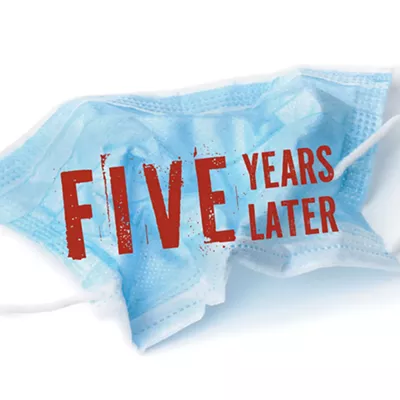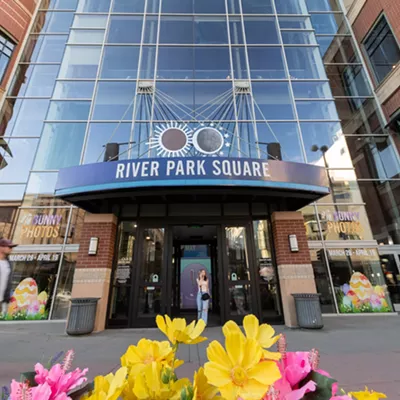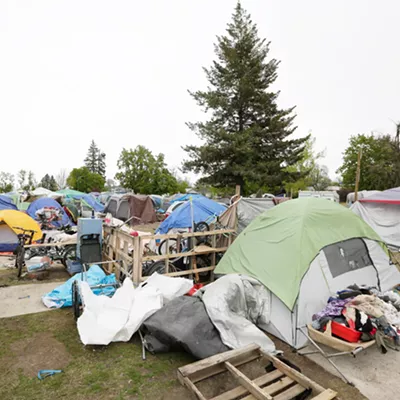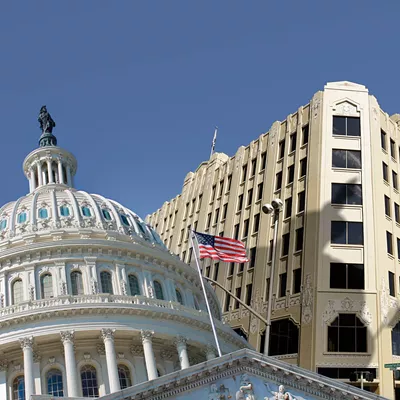
Last month, with neighbors complaining about the sheer quantity of dust coming from Spokane's city Water Department complex on North Foothills Drive, the City Council unanimously passed a resolution calling for the department to relocate some of its work.
"One of the things that we know is the amount of dust in the air causes a significant amount of health problems," City Council member Jonathan Bingle said at the council meeting.
And nobody knows that like those who worked for the Water Department.
According to public records recently obtained by the Inlander, Water Department employees worried that the air inside the department's main building near Gonzaga Prep had become poisonous. And not just from the dust.
It was Jan. 12, 2021, the deadliest month of the COVID pandemic.
Like the canaries carried into coal mines, the department's clerks were the first to know. They could feel the air scratching their throats and coating their mouths. It burned their eyes and chests. It was hard to breathe.
It got so bad that the whole building was temporarily evacuated a week later — under suspicion that there may have been a gas leak.
The city brought in experts, who discovered the building didn't just have a dust problem — it had excess carbon dioxide and radon, too.
"Any one of these can cause minor to serious acute and chronic health effects and in combination create an unhealthy work environment," a report from Spring Environmental, a third-party consultant concluded in April 2021, saying the issue stemmed from a "direct result of inadequate fresh air flow throughout the facility."
To Marlene Feist, Spokane's director of public works, the city's response to the complaints was proof of how much they care about employee safety. The clerks were allowed to work from home and eventually moved to another building on the site. The city spent tens of thousands of dollars diagnosing the problem, and eventually installed a slew of upgrades to the building's air handling system.
"We got recommendations to improve that outside airflow into the building," Feist says. "We've done that."
But it wasn't just the clerks who had complaints. Half of the employees in the basement of the main building had been complaining of headaches. Ryan Egger, a 6-foot-3-inch bearded former Water Department foreman, was one of them. As the clerks were transferred out, he says he and at least five others were stuck crammed into a tiny "sardine can" of an office in the basement.
Today, he accuses the department of not only failing to quickly fix the toxic air — but of being the reason he contracted a nasty case of COVID.
"I had some trust in you as you talked to the water department management about family, family, family," Egger wrote in a January 2022 email to then-City Administrator Johnnie Perkins. "My family has suffered at the expense of poor leadership and pure conscious negligence."
WIND AND FIRE
As soon as the Spring Environmental technician walked into the department's basement office two years ago, Egger says, his face said something was wrong."The guy comes in with his handheld thing, his eyes [bug out], and his jaw drops," Egger says.
Carbon dioxide levels were elevated, but not so high as to be dangerous. All the headaches and nausea? That was likely caused by "particulate matter" — unidentified stuff floating in the air, setting off the air filters in the building. At its worst, the effect was like experiencing a moderate to severe wildfire smoke day inside the office.
Egger wasn't surprised. At that time, he says, all four sides of the buildings were surrounded by construction, demolition or big dusty dirt piles bound for the state's North Spokane Corridor project, also known as the north-south freeway.
Once upon a time, the department's basement was supposed to be one of the safest places you could possibly be in the event of a nuclear attack. The site had been one of Spokane's 176 designated fallout shelters.
But there were issues with airflow a half-century ago too. During a packed 29-hour fallout shelter simulation, a Spokane Daily Chronicle article from 1967 detailed a comic mishap involving a nun's veil and the "big blower used to push fresh air into the stuffy shelter."
Flash forward a half-century, and that stuffiness had ironically helped turn the former shelter into a sink for radioactivity.
Spring Environmental tested for radon — a radioactive substance naturally occurring in the soil in places like Spokane, that is measured in "picocuries." (A measurement named after Marie Curie, the scientist famously killed due to her radiation exposure, who remains the only person to win a Nobel Prize in two scientific fields; in her case, physics and chemistry.)
If you find just 4 picocuries per liter of radon in your home, the Environmental Protection Agency says you need to take action to address it. In April 2021 the Water Department's basement was popping with 62 picocuries per liter.
Though it was shy of the controversially loose federal radon limit for workplaces, at the "relatively high level" in the Water Department's basement, action was clearly needed, says Jim McAuley, a radon specialist with the EPA.
"The higher the level the more chance you have of getting lung cancer," McAuley says. The EPA says radon-caused lung cancer kills roughly 21,000 Americans a year.
Granted, McAuley says that fixing the radon problem didn't have to be immediate. Just like getting one X-ray or a single night of secondhand smoke, it's not one day that's the concern. It's the buildup over months and years.
But Egger says it took nearly five months after the first radon test for even the most basic intervention — portable industrial fans to improve the airflow — to be added to the basement offices.
And by then, Egger says, he was at the hospital in the wake of the department's big COVID outbreak.
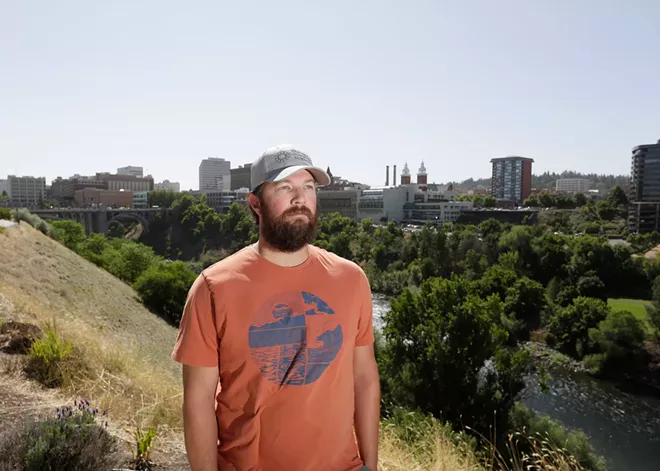
WATER AND EARTH
Even before COVID, recently retired Water Department employee Tim LaForce says the department's building — the "dungeon" as he calls it — long had a reputation as a petri dish.
"I got the flu and cold several times, just from being down there," LaForce says. "You could hear people coughing and hacking and everything."
Some guys at the water department, like LaForce, had good reasons to be concerned about the virus. Part of his leg is missing. Long story short: On the job injury. Botched surgery. Infection. Amputation.
"Because of the medications that I'm on, my immune system is compromised as it is," LaForce says. "I've got a 40-year-old special needs daughter. I was terrified I'd bring home something to her and she'd die."
But there are also people like supervisor Loren Searl. In interviews for this article, three former city employees said that the "mask" Searl wore during COVID was mesh without any liner — essentially like wearing fishnet stockings over his mouth.
Egger took it as a "middle finger at people who had health concerns."
He knows there's plenty of debate about how effective masks were against COVID. But the rules were the rules — and he says the Water Department has long had a reputation of playing fast and loose with safety rules.
And in this job, he worries, that can be deadly. Fail to properly "shore" up the trench that you're digging, for example, and you could end up hospitalized like the employee who in 2018 was buried under a ditch after a dig collapsed at 57th Avenue and the Palouse Highway. An investigation by the Washington state Department of Labor and Industries resulted in a $4,800 fine against the city for not following safety procedures.
And yet by 2021, at least 90 employees were out of date on their "shoring/trenching" training to avoid those kinds of accidents, Egger says. (Feist argues that COVID was partly to blame for the delay.)
Finally, in May 2021, the city took action. Safety training was held for three straight days, roughly 30 employees at a time, to try to get staff in compliance with state rules — but inside the exact same fallout-shelter basement where the city knew the ventilation was toxically inadequate.
It was exactly the kind of low-ventilation environment that could turn into a COVID hot zone. The safety training turned into a superspreader event.
Even though COVID cases nationwide were low, even though the Delta variant wave hadn't hit yet, even though Egger said he'd been vaccinated, Egger got COVID. And he wasn't alone.
"I've confirmed face-to-face with at least 16 guys when I returned to work that 'Yes, I tested positive,'" Egger says.
Though LaForce dodged the virus, he submitted a complaint to the state in June 2021, estimating that 20 to 30 water employees were out sick following the training.
Though the city sent out a wear-your-mask-reminder to employees, the Water Department's safety coordinator and manager claimed that the Labor and Industries instructor teaching the class didn't indicate he observed any COVID regulation violations.
But at least three employees at the training confirmed for this article that a slew of their co-workers at the training weren't masked up — and that it wasn't a surprise that the trainer didn't raise an objection. LaForce says the trainer took his own mask off halfway through his session.
Egger places the blame squarely on the city: They knew the room was dangerous.
"Why didn't they vacate it months ago and figure out what's going on?" Egger says. "Instead we all ended up with COVID."
HEART
Over a decade ago, Egger's heart had stopped on the operating table. The doctors put in a pacemaker to save his life, and for 15 years, he was fine. COVID, he says, changed that.
"Initially, it was a lot of cardiac complications. Heart beating out of my chest, really a lot of dizziness," Egger says.
Long COVID is an amorphous thing — hard to diagnose, hard to pin down.
"I tell everybody it's like having an eggbeater taken to your brain," Egger says.
Records show that Egger did meet with Feist and Perkins to share his concerns — but as his emails grew increasingly outraged, Perkins shifted to a more defensive talk-to-HR stance.
It's only now, two years after having COVID, that he says he's starting to feel better. Just last month, he says, the city finally settled his claim with Labor and Industries.
Feist stresses that even medical facilities, with all their precautions, had outbreaks.
"COVID was one concern. So was making sure we were delivering safe drinking water," Feist says. "We tried to do absolutely everything we could to do all of these things at the same time."
The city has continued to upgrade the facility — with new air handling systems and better exterior doors to limit outside pollution. The better ventilation worked: A followup test in September 2021 showed that radon and particulate matter levels had fallen significantly.
Yet in late 2021, Water Department Director Stephen Burns was fired. Feist won't say whether the air quality issue played into his termination, only that the city made a decision to go in a "different direction."
But that different direction ultimately meant Searl — the supervisor who reportedly wore the mesh-mask — was the new head of the Water Department. For all of Egger's criticism of Burns' tenure, he says Searl was a much bigger problem.
Ultimately, the Water Department is the only Spokane city department to get a COVID-related violation from Labor and Industries.
In February 2022 — nearly two years into the pandemic, and just after the milder but more contagious Omicron variant had resulted in skyrocketing infections — Labor and Industries responded to an anonymous employee complaint about masking in the department. The state fined the city $2,100, concluding that the department wasn't enforcing all the state's policies around facial covering and COVID barriers. It hadn't provided "a workplace free from recognized hazards... likely to cause serious injury or death."
In an email, city spokeswoman Kirstin Davis argues that that's the product of exhaustion after two years of complying with pandemic mandates.
But Egger takes it as more evidence of the kind of behavior that can lead to ditch collapses and disease outbreaks.
"That proves my point that Water does what they want," Egger says "They had my situation in 2021 and still didn't clean up their act." ♦



